Bavaria (Germany) – detailed information about the region with photos. The main attractions of Bavaria with a description and the most interesting cities.
Contents
Federal State Bavaria (Germany)
Bavaria (Bayern) – the federal state in the south of Germany. It has status of a free state and is the largest administrative-territorial unit of Germany. Bavaria bordered by The Czech Republic and Austria, occupying a picturesque area from the Alps to the valley Danube. This region is one of the most beautiful and interesting places in Germany, including a unique atmosphere combined with huge historical and cultural heritage.
Bavaria has a rich history and is famous for its beautiful natural landscapes. This land is one of the most distinctive regions. Germany with an abundance of old sights and monuments architecture. On the territory of Bavaria is a huge amount romantic castles, luxurious palaces and ancient churches. But the most The main highlight of this region is the charming historical cities that have retained their medieval charm.
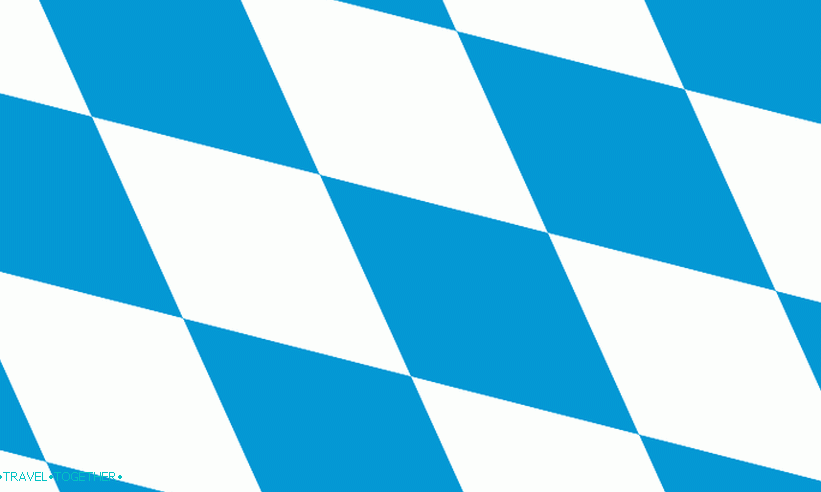 Flag of bavaria
Flag of bavaria
- Geography and climate
- Best time to visit
- Practical information
- Cities of Bavaria
- Story
- How to get there
- Food and drink
- sights
- Video
- Comments and reviews
Geography and climate
Bavaria occupies the southern and southeastern parts of Germany. This The region has a stunning natural diversity. In the east Bavaria has the mountain ranges of Fichtelgebirge and Franconian Forest, Alps peaks to the south, hills to the west Shtufenland, and in the north – the low mountains of Rhön and Spessart. In terms of The relief area of Bavaria can be divided into three large areas: northern Kalkalpen and the Bavarian Alps, the hilly Bavarian plateau, German middle mountains.
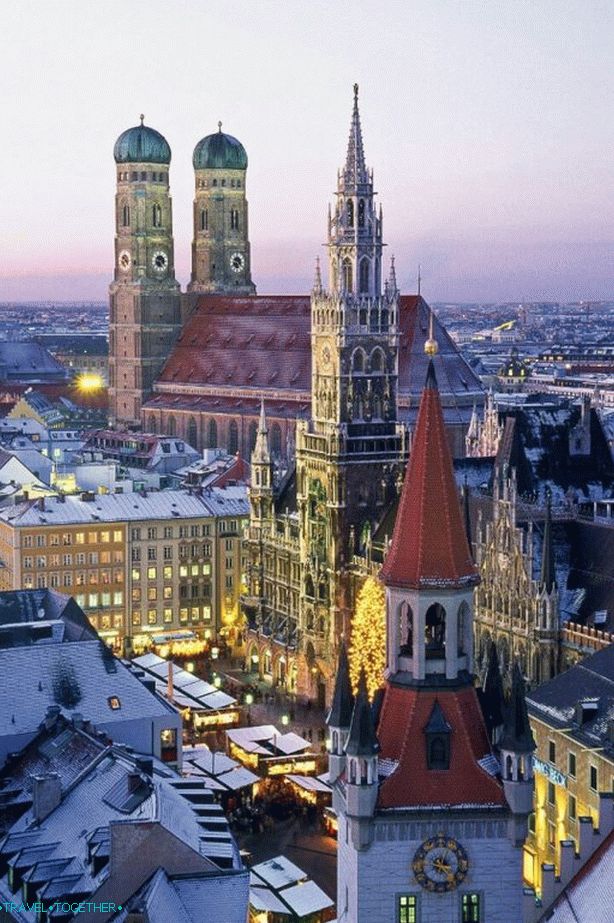 Munich – the capital Bavaria
Munich – the capital Bavaria
The territory of Bavaria is permeated with many rivers. Most of them flow into the Danube. Also Bavaria is known for a huge number of lakes. There are more than 1,500 of them here. The largest lakes in Bavaria are Chiemsee, Ammersee, Lake Starnberg, Tegernsee, Königssee.
In the Bavarian Alps there are many ski slopes. The largest ski resort is Garmisch-Partenkirchen.
Bavaria is one of the warmest regions of Germany. This The federal state has a warm temperate climate that becomes colder and more continental closer to the Alps. Bavaria climate characterized by warm summers and cool winters with small negative temperatures.
Best time to visit
Bavaria is the southernmost and warmest region of Germany, so visit It can be all year round. But there is a time that is considered the best. and atmospheric is summer, October when Oktoberfest passes, and Christmas period.
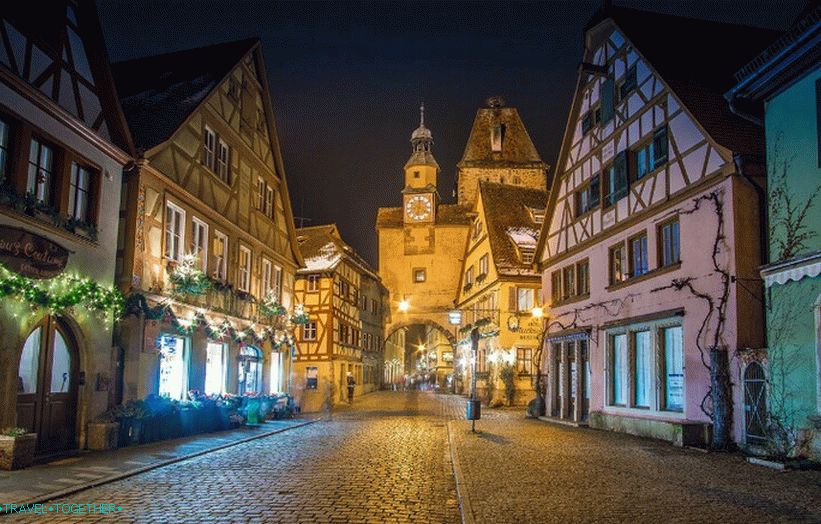 Rothenburg ob der Tauber
Rothenburg ob der Tauber
Practical information
- The population is 12.8 million people.
- The area is 70 550.07 km².
- The language is German. Also common Bavarian dialect.
- Visa – Schengen.
- Time – Central European (UTC +1, summer +2).
- National composition – Bavarians, Franconians, Swabians.
- Currency – Euro.
- The largest cities are Munich, Nuremberg, Augsburg, and Würzburg. Regensburg.
- Bavaria is one of the richest and most economically developed lands. Germany. GDP (per capita) is almost 40,000 euros.
- Bavaria is one of the most popular places in Germany. Her annually visited by more than 30 million tourists.
- Most of the population professes Catholicism.
A little about the Bavarians … The Bavarians are the proudest of all Germans and very revere their traditions. This region is the most autonomous federal state of Germany, which is expressed literally in everything. Interestingly, most locals consider themselves first turn Bavarians and only then by the Germans. It’s pretty conservative people, except perhaps liberal Munich
Cities of Bavaria
Bavaria is famous for its stunning cities, soaked history, cultural traditions and authentic the atmosphere.
Munich is the capital of Bavaria and one of the largest German megacities. This dynamic city is an economic and cultural center of the region, as well as a popular tourist destination including a wide variety of tourist attractions: from exploring the old sights and museums to gastronomy and shopping.
 Nuremberg
Nuremberg
Nuremberg is the second most populated city of Bavaria with magnificent historic center incorporating medieval Kaiserburgi imperial castle five stunning gothic churches. Nuremberg has a rich millennial history and is famous for toys, gingerbread, as well as a charming atmosphere and antique architecture.
Augsburg is the capital of the historic Swabia region. Is one from the oldest cities of bavaria and has a rich historical heritage.
 Regensburg
Regensburg
Regensburg is one of the oldest cities in Germany, which has stunning historic center included in the list of objects UNESCO World Heritage Site. Its main attraction is a beautifully preserved medieval altstadt with Gothic cathedral and ancient stone bridge, which, moreover, the largest in size on German soil.
Lindau – the pearl of Bavaria, located in the eastern part Lake Constance in the vicinity of Austria and Switzerland. It is a beautiful city in which you can immerse yourself in labyrinths of small streets and century-old houses.
Füssen is a romantic old city, as if painted hand artist. Surrounded by stunning mountain peaks and picturesque lakes.
 Würzburg
Würzburg
Würzburg is an ancient city located on the hills of Franconia in the center of the wine region. Has a magnificent historical the center, restored post of the destruction of the Second World War, the jewel of which is the baroque masterpiece Residenz.
Dinkelsbühl is located in central Franconia in the northern part Romantic road. This old city has not changed much since Medieval and filled with old churches, half-timbered houses and charming streets.
 Rothenburg ob der Tauber
Rothenburg ob der Tauber
Rothenburg ob der Tauber is one of the most beautiful cities Europe with a fabulous historical center that includes a maze of narrow streets and bright old buildings. He will hit a real medieval charm and almost completely surviving city walls with gates and towers. Rothenburg on the river Tauber considered to be one of the most authentic and photogenic old cities of Bavaria.
Passau – a picturesque old town located at the confluence three rivers: the Danube, Inna and Ilza. Famous for its magnificent historic atmosphere and sacred architecture.
 Passau
Passau
Bamberg – a fascinating city on the Regnitz River, the historic center which is included in the UNESCO World Heritage List. Bamberg is famous for its traditional Bavarian atmosphere and is one from brewing centers. The city is filled with medieval streets and old sights, among which stand out old island town hall, gothic cathedral and baroque Residence.
Top Destinations
 Bavarian Alps
Bavarian Alps
- Ammersee is a picturesque lake in Upper Bavaria.
- The Bavarian Alps are Germany’s highest mountains with stunning nature and ski resorts.
- Bavarian Forest – a picturesque natural landscape, which is called “Bavarian Siberia”.
- Berchtesgaden National Park, where the deepest lake in the alps.
- Chiemsee is the largest lake in Bavaria with the Bavarian Versailles on against picturesque mountains.
- Romantic road – a charming tourist route past romantic medieval castles and cities.
Administrative division
Bavaria is divided into 71 districts and 25 cities “land submission. ”
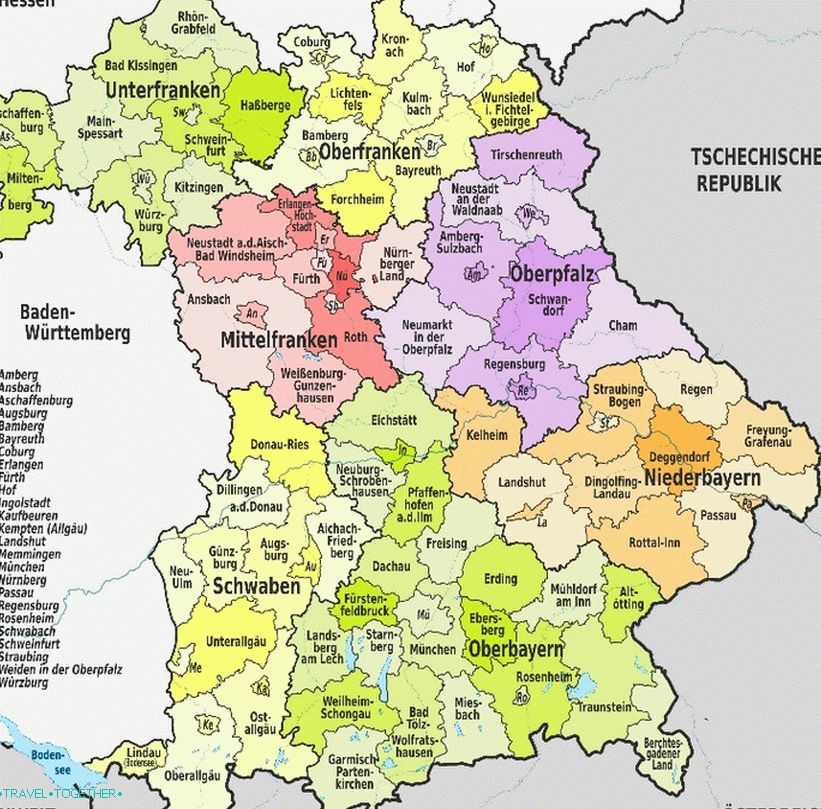 Administrative division of bavaria
Administrative division of bavaria
Regionally, Bavaria’s territory can be divided into five regions (historical regions):
- Franconia, occupying the north and northwest.
- Swabia in the southwest.
- Upper Palatinate in the northeast.
- Upper Bavaria in the south.
- Lower Bavaria in the east.
Story
The territory of Bavaria was inhabited in ancient times. On these lands lived Celtic tribes and Etruscans. In the 1st century BC. Bavaria was conquered by the Romans, who divided its territory into two provinces – Retsiyu and Norik. In the 3rd century AD, with the beginning of the decline of the Roman empires, provinces began to threaten the Germanic tribes. In the 5th century The Bavarian lands were occupied by herrules, rugs, and skiers, whom drove the Huns out of the valley of the Danube. At the beginning of the 6th century, it was established Marcomanni and Quad tribes who came from Bohemia. They were later called Bavarians. Then the territory of Bavaria was subordinated to the Ostrogoths, and then francs.
At the end of the 6th century, the Duchy of Bavaria was formed, which in the result was broken and conquered by the Franks. At the same time, Bavaria has kept significant autonomy. Under Charlemagne, the Bavarian lands and the territory of Italy was inherited by his son Pipin, who died while father’s life. Then Bavaria belonged to the kings of the dynasty Carolingian, which in the 10th century replaced the Ludolfing and Welfy.
 Nuremberg
Nuremberg
At the end of the 12th century, Bavaria passed to Otto from the dynasty Wittelsbach, who is considered the founder of the Bavarian clan the dukes. Over the next five centuries, the duchy experienced ups and downs, until the end of the Holy Roman Empire. In 1742, Bavaria was conquered by Austria. But the Austrians owned Bavarian lands not for long. In 1745, Maximilian Joseph returned Bavaria as part of the Holy Roman Empire.
At the Congress of Vienna in 1815, Bavaria was recognized independent kingdom that existed until the second half of the 19th century. In the Austro-Prussian War of 1866, Bavaria lost a number of territories, and already in 1870 finally joined the German Union. Although the last Bavarian king abdicated the throne in 1919. During the time of the Third Reich Germany’s federal structure was abolished, and Bavaria was divided into several administrative units, which were called Reichsgau. During the Second World War, a number of large Bavarian cities were heavily bombarded and were heavily destroyed.
How to get there
Bavaria has excellent transport accessibility. In munich and Nuremberg has major international airports. If suddenly, you will not find a flight to Munich, then you can fly in a huge air port of Frankfurt am Main.
 Airports Bavaria
Airports Bavaria
Bavaria has excellent rail connections with most major cities of Germany, including also high-speed trains. Also by train you can get here from Prague, Vienna, Linz, Salzburg, Villach, Klagenfurt, Paris, Amsterdam, Rome, Venice, Verona and other European cities.
Food and drink
Bavarian cuisine is quite distinctive and famous following dishes: Schweinsbraten (roast pork), legendary Bratwurst (Bavarian grilled sausages), Weißwurst (sausages from veal), Leberkäse (meatloaf), Schweinshaxe (pork knuckle on grill), Knödel (potato or bread balls), Kartoffelsalat (potato salad), Kässpatzen (cheese dish).
 Famous bavarian bratwurst
Famous bavarian bratwurst
Bavaria is famous for its beer, which is considered one of the best in the world. Foamy drink for Bavarians is an important part of their culture. There is even a saying “Hopfen und Malz, Gott erhalts” that means “Hop and Malt, God bless them.” Most popular grade Beer is the Weißbier (wheat unfiltered), which serves in special glasses Weißbierglas. Also Bavaria is known for beer Festivals, the season which begins in April and continues until October, culminating in a massive Oktoberfest.
Bavarian land is famous not only for beer. Franconia is a large wine region known for excellent white wines. Very unusual is Eiswein (ice wine) made from grapes, which is collected only after the first frost.
sights
Bavaria is famous for a huge number of magnificent attractions. Here in almost every historic city you can find a striking old cultural monument or architecture. Therefore, only the most famous are listed below. symbols of this region.
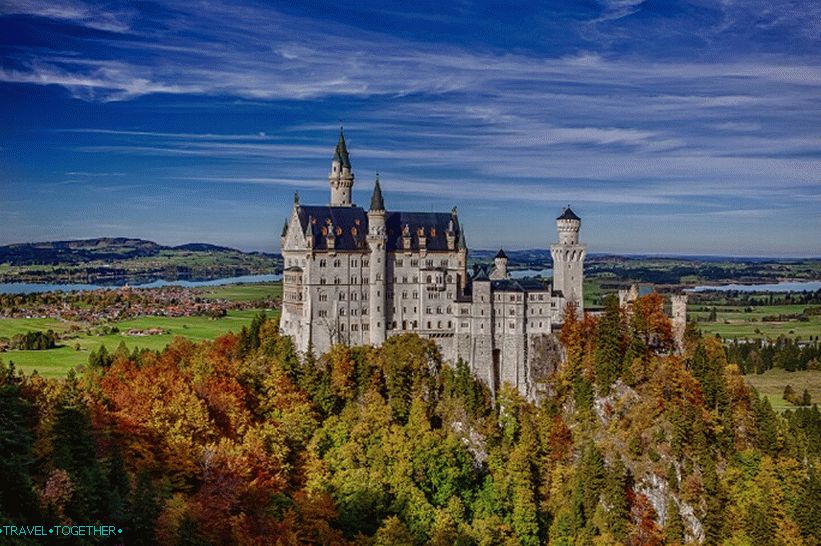 Neuschwanstein
Neuschwanstein
Neuschwanstein (or “New Swan Castle”) – fabulous neo-romanesque castle built on a rocky cliff in the 19th century “mad” Bavarian king Ludwig II near the town Fussen. This fancy architectural creation is considered one of symbol of Germany. The spiers and towers of the castle dominate the forest and by the lake. Behind them the amazing panorama of the Bavarian Alps opens. The castle has luxurious interiors inspired by heroic legends and romantic literature.
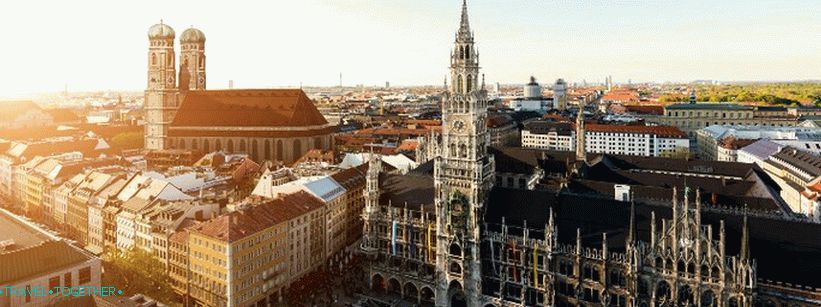 Marienplatz and New Town Hall
Marienplatz and New Town Hall
Marienplatz – the heart of Munich with a grand neo-gothic building New Town Hall, built in the early 20th century. Slightly away from the square is the Frauenkirche – the magnificent cathedral, built in the 15th century which is a late masterpiece gothic
In the eastern part of Marienplatz, you can look at two at once. interesting buildings. Old Town Hall – an ancient building of the 14th century gothic style. In her tower is now located a toy museum. Beside with the Old Town Hall is located the Cathedral. Petra – the oldest parish Munich Church, founded in the Romanesque period. Her story has more than 8 centuries. The church is a famous symbol Munich and combines elements of different architectural styles.
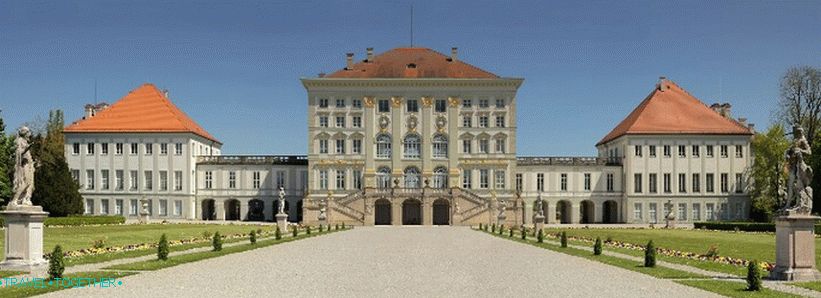 Nymphenburg
Nymphenburg
Nymphenburg – a magnificent palace with a picturesque garden and the channel, which is one of the most famous landmarks Munich Built as the summer residence of the Bavarian kings, Palace impresses with luxury and strict forms. Building Nymphenburg dates back to the 17th century. The architect was made by Italian Barelli. Now here you can evaluate the life of monarchs and see art objects.
No less famous is the palace park – 229 hectares of park landscape in the English style. Through the palace canal you can make gondola ride.
Also in Munich there is another magnificent palace complex – The residence, which is considered one of the most impressive palaces Europe. The residence includes seven large courtyards and consists of three main parts: late Renaissance Old Residence, Königsbau (Royal Hall) and Festsalbau (Banquet Hall) overlooking Hofgarten and the magnificent 16th century Antique.
 Kaiserburg
Kaiserburg
Kaiserburg is a true symbol of Nuremberg. From medium depth centuries its silhouette symbolizes the power of the Holy Roman Empire, and also a huge role in the history of Germany and the German nation. Kaiserburg located in the heart of the old town of Nuremberg on top of a cliff out sandstone. It is often called the imperial castle, although the remaining part is just fragments of the complex arrangement of the castle.
Kaiserburg – one of the most important surviving medieval fortresses in Europe and the birthplace of the German kings and emperors on over 500 years. Includes several historical Structures: 15th Century Imperial Stables, Pentagonal Tower 12th century, well house of the 14th century, round tower of the 13th century century, the actual imperial palace of the 11th century and the chapel of the 13th century.
Also very beautiful is the old city of Nuremberg. Here preserved charming narrow streets and ancient buildings, about 4 km medieval walls and magnificent gothic churches.
 Linderhof
Linderhof
Linderhof – the luxurious summer palace of the “insane” Ludwig, located in a picturesque area among cool green forests. Built in the 19th century in neorokoko style.
 Regensburg
Regensburg
Regensburg is one of the oldest and most interesting for tourists. cities of Bavaria. It has the largest medieval center in which there are two magnificent sights. The first is stone bridge over the Danube, which is a medieval masterpiece architecture and dates from the first half of the 12th century. Almost 800 years until 1935, it remained the only bridge that connected two shores of Regensburg.
The second iconic landmark of this Bavarian city is cathedral of sv. Petra. This is one of the oldest religious structures of Bavaria and the pearl of Gothic architecture. AT The architecture of the cathedral stands out for its high Gothic towers, which are visible from almost all points of the historical center. Also impressive are the colorful medieval stained glass windows and Gothic vaults.
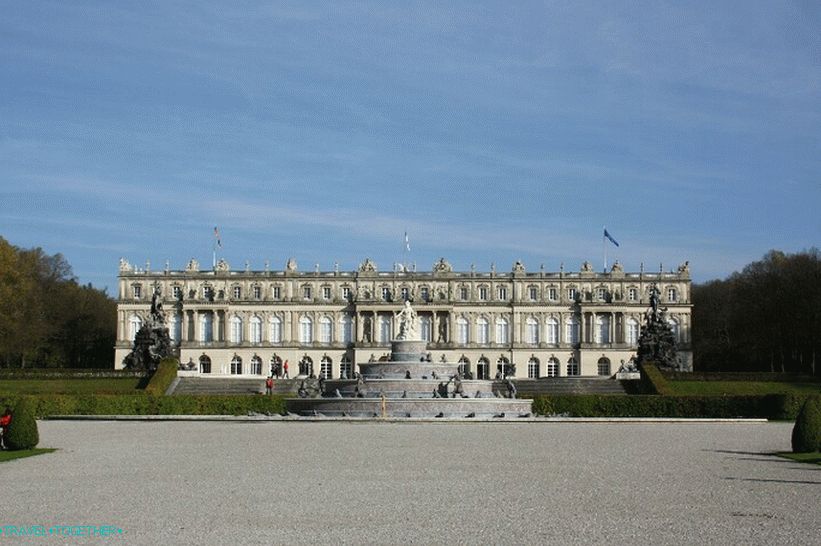 Herrenkimze
Herrenkimze
Herrenkimze – the country residence of the Bavarian King Ludwig II, located on an island in the middle of Lake Chiemsee. This baroque the palace was built in the second half of the 19th century as an analogue French Versailles, but in fact was never completed.

Bamberg Cathedral – one of the main attractions Bamberg and a masterpiece of Gothic architecture. The church was founded in The 11th century is the legacy of Emperor Henry II. It is beautiful Gothic building with Romanesque details and four high towers, which is the architectural dominant of the Cathedral square. Here found the last rest Emperor Henry II, King Conrad III, Pope Clement II (the only Roman Pope, who is buried north of the Alps). In the cathedral are beautiful portals, decorated with bas-reliefs, and in its interior you can see many quaint antique elements.
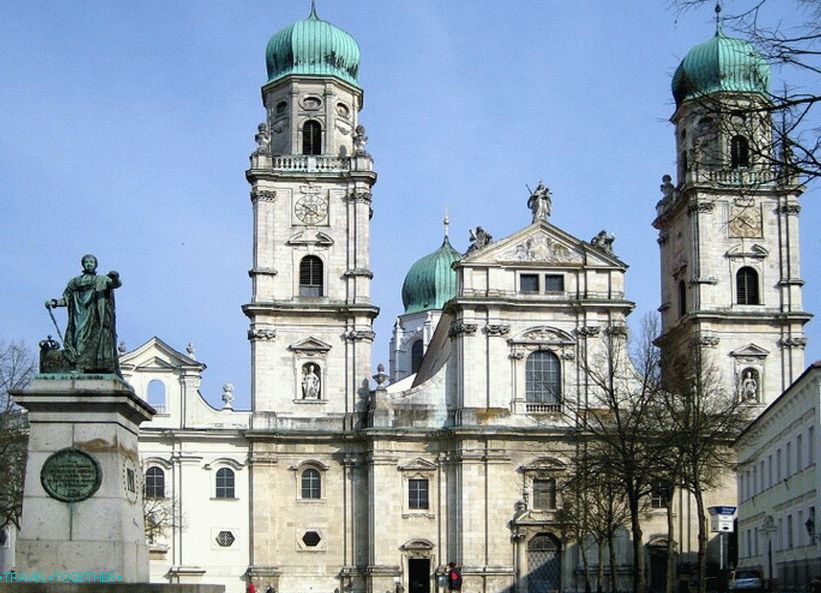 Cathedral of sv. Stefan
Cathedral of sv. Stefan
Cathedral of sv. Stephen – the pearl of the sacred architecture of Passau. This The old church combines the magnificent architecture of the Baroque and elements of the late gothic and also has the largest church organ in Europe.
 Residence in Würzburg
Residence in Würzburg
The residence in Würzburg is an incredibly beautiful 18th century palace, famous for its luxurious rococo and baroque architecture. He can boast a large fresco by Venetian painter Tiepolo, complex staircase and a variety of decorative halls.






